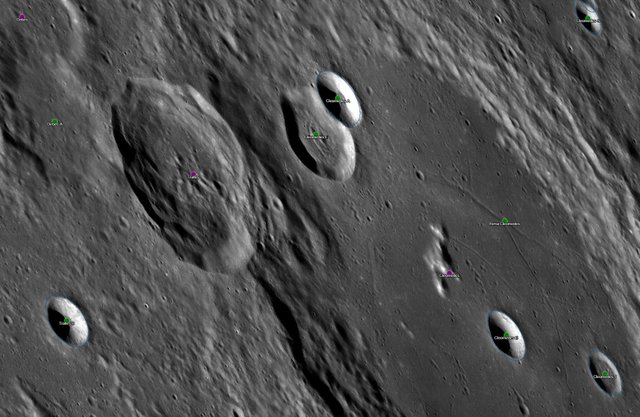RE: Remote Viewing the Dark Side of the Moon III
Hello @v4vapid, I think I can add a bit more info on some of the photos you have presented here. It takes a while to research everything so I'll just tackle some the images under "Screen Shots" where you have a red arrow pointing to a feature on the moon. I just happen to have home observatory that was setup to take photo's of the planet Jupiter and the full moon was nearby so I decided to take some images of that area. Here it is (you can click the image for a bigger view). It turns out this feature is called Cleomedes E and Cleomedes A.
Additionally, I accessed the Lunar Reconnaissance Orbiter image from their website . I found the area around Cleomedes and have copied it here. You will need to click the image for the larger version which has labels. Its not in quite the same orientation so you need to adjust a little for this (but Cleomedes A and E are the twin craters near the middle top)
Hope this is of interest.


Well sheeeeiit, thanks @terrylovejoy I appreciate that you took the time to find and name this crater and it's features for me.
In light of these images, I think I need to reassess my own assumptions. I'll be honest, perhaps I was seeing what I wanted to see in these photographs. I searched for Cleomedes and found a lot of information pertaining to these formations.
As an amateur astronomer what do you make of the hexagon shaped craters that cover the moon's surface especially on the far side of the moon? I believe there are similar hexagon shapes on the surface of Mercury and some of the Gas planet moons as well.
Also, do you have any opinion as to why we haven't set foot on the Moon since the seventies?
Thanks for your feedback much appreciated.
No problems @v4vapid it was a fun bit of detective work! Sometimes it's hard identifying stuff on the moon as the lighting angle changes and therefore the way the shadows fall change which in turn dramatically alters the appearance of the lunar terrain.
I don't know what causes those hexagon shaped craters, they seem to crop about from time to time on lots of different objects. This one on asteroid Ceres is pretty cool - https://www.jpl.nasa.gov/spaceimages/details.php?id=PIA21399
Did you know about Saturns north polar hexagon? I don't think anyone knows why these form the way they do, lots of things we still have to learn :)
I don't know why we didn't go back to the moon...I always assumed dollars, but I really don't know.
Thanks for the Ceres image, I haven't seen this before but I recently became aware of the Saturn hexagon at the pole! Now that is something strange...I saw somewhere that there's another hexagon at the south pole region of Saturn as well. I don't know what to make of it but it sure is mysterious. However, there are a number of naturally occurring hexagons on Earth such as snowflakes and crystals so maybe it's not so strange.
Btw thanks for the vote on my last blog post...that was very generous of you!